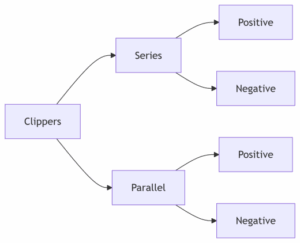
Clipper and Clamper Circuits are fundamental in modern electronics, providing precise waveform shaping and signal conditioning. These circuits help control voltage levels by either limiting the amplitude of a signal or shifting its DC level without altering its basic shape.
Using simple components like diodes, capacitors, and resistors, clipper and clamper circuits are widely applied in voltage protection, DC restoration, and pulse shaping. From communication systems to biomedical and power electronics, mastering their operation is key to designing reliable and efficient electronic systems.
In electronics, signals often need to be reshaped, limited, or shifted without changing their basic structure. This is where clipper and clamper circuits come into play. These simple yet powerful analog circuits are widely used in communication systems, power electronics, and signal conditioning circuits.
They ensure signals stay within safe voltage ranges, remove unwanted spikes, and restore lost DC levels, making them essential for both learning and practical engineering.
A clipper circuit (also known as a voltage limiter) is used to restrict the amplitude of a signal without distorting its overall shape. It ensures that signals do not exceed a specific voltage level.
A clipper circuit removes (clips) a portion of the input signal without distorting the remaining part. Clippers are broadly classified into series and parallel types, and further into positive and negative clippers.

A clamper circuit shifts the entire input signal either upward or downward without changing its shape. It uses a combination of diodes, capacitors, and resistors to achieve this voltage level shift.

A clamper circuit (also known as a DC restorer) shifts an entire signal up or down along the voltage axis without altering its shape.
| Feature | Clipper Circuits | Clamper Circuits |
| Function | Limits voltage peaks | Shifts the waveform level |
| Key Component | Diode clipper circuit | Diode clamper circuit |
| Example | Zener diode clipper (voltage protection) | Biased clamper circuit (controlled shifting) |
| Applications | Voltage protection circuits, pulse shaping circuits | Signal conditioning circuits, DC restoration |

Clipper and clamper circuits are fundamental building blocks in electronics. From voltage limiter circuits to DC restorers, they enable precise signal conditioning, voltage protection, and pulse shaping. By mastering these concepts, whether through diode clipper circuits, Zener diode clippers, or biased clamper circuits, you will gain the foundation needed for advanced design in embedded systems, communication, biomedical, and power electronic applications.
A clipper circuit limits the amplitude of a waveform to a set voltage level, while a clamper circuit shifts the entire waveform up or down without altering its shape.
Clipper circuits are used in voltage protection, noise suppression, pulse shaping, and to prevent signals from exceeding safe voltage limits in communication and power electronics.
Clamp circuits restore or shift the DC level of a waveform, which is crucial in applications such as TV signal synchronization and biomedical signal baseline correction.
Both circuits commonly use diodes, resistors, and capacitors. Clippers may also use Zener diodes for voltage regulation, while clampers rely more on capacitors for level shifting.
No. Clippers only remove parts of the signal beyond a set threshold, while clampers shift the entire waveform. The basic signal shape remains unchanged in both cases.
A Zener diode clipper is often used in voltage protection circuits to prevent MOSFET gates or sensitive components from exceeding their voltage rating.
In television systems, a negative clamper circuit restores sync pulses to 0V for proper synchronization, ensuring a stable image display.
Indian Institute of Embedded Systems – IIES